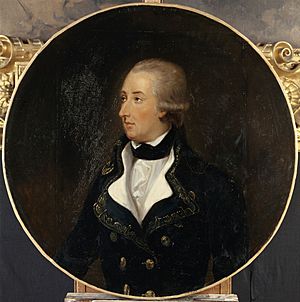Arthur Dillon (1750–1794) facts for kids
Quick facts for kids
Arthur Dillon
|
|
|---|---|

Painting by Jean-Hilaire Belloc, 1834
|
|
| Born | 3 September 1750 Braywick, Berkshire, England |
| Died | 13 April 1794 (aged 43) Paris, France |
| Allegiance | |
| Rank | General |
| Battles/wars | American Revolutionary War French Revolutionary Wars |
Arthur Dillon (1750–1794) was an Irish nobleman who was born in England. He became the leader of a French army group called a regiment. This regiment fought for France during the American Revolutionary War and later during the French Revolutionary Wars. After holding political jobs early in the French Revolution, he was put to death in Paris in 1794. This happened during a very strict time known as the Reign of Terror.
Contents
Early Life and Family
Arthur Dillon was born on September 3, 1750. His birthplace was Bray Wick in Berkshire, England. He was the third child of Henry Dillon, who was the 11th Viscount Dillon. His mother, Charlotte Lee, was the daughter of George Lee, the 2nd Earl of Lichfield.
Arthur had several brothers and sisters:
- Charles (1745–1813), who became the 12th Viscount Dillon.
- Frances (1747–1825), who married Sir William Jerningham.
- Arthur (1750–1794).
- Catherine (1752–1797).
- Laura (born 1754).
- Charlotte (1755–1782), who married Valentine, the 1st Earl of Kenmare.
- Henry (1759–1837), who later led Dillon's Regiment.
Becoming a Colonel
When Arthur was just 16 years old, on August 25, 1767, he became the colonel of Dillon's Regiment. He took over this role from his father. His father had been the colonel for twenty years, from 1747 to 1767.
First Marriage and Children
At the age of eighteen, Colonel Dillon married his second cousin, Therese-Lucy de Rothe (1751–1782).
Arthur and Thérèse-Lucie had two children:
- George, who sadly died when he was two years old.
- Henriette-Lucy, also known as Lucie. She later became Henriette-Lucy, Marquise de La Tour du Pin Gouvernet. She wrote important memories about the time of the French Revolution and the Napoleonic era.
Arthur Dillon later became the grandfather of another military officer, also named Arthur Dillon.
Fighting in the American Revolutionary War
In 1778, France joined the American Revolutionary War (1775–1783). France decided to help the Americans against Britain. Colonel Dillon and his regiment sailed to the Caribbean. There, they fought against British forces under the command of D'Estaing.
In 1779, Arthur Dillon and his regiment fought in the Capture of Grenada. They were up against British forces led by George Macartney. Dillon's troops landed on July 2 and attacked Hospital Hill. This was where the British had set up their main defense. Arthur personally led one of the attack groups, and his brother Henry led another. Macartney surrendered on July 5. The next day, July 6, 1779, a British fleet appeared off the island's coast. This led to a naval battle called the Battle of Grenada.
In September and October 1779, Dillon also fought in the Siege of Savannah. During this time, he was promoted to brigadier. After the Treaty of Paris ended the war, he became the governor of Tobago.
Second Marriage
After his first wife passed away, Arthur Dillon married again. His second wife was Laure de Girardin de Montgérald. She was a wealthy French Creole widow from Martinique. She was also known as the Comtesse de la Touche. They had six children together. One of their children was Élisabeth Françoise 'Fanny' Dillon. She later married Henri Gatien Bertrand.
Later Life and Death
Arthur Dillon returned to Paris. He represented Martinique in the Estates General of 1789. He was a royalist who believed in democratic reforms.
It was a very difficult time for army officers who came from noble families. On April 29, 1792, his cousin Théobald Dillon was killed by his own soldiers after a small fight. After the Battle of Valmy, Arthur Dillon was given command of 16,000 troops.
However, two weeks later, Dillon was called to Paris for questioning. He was arrested on July 1, 1793. This happened even though his aide-de-camp, François Séverin Marceau-Desgraviers, strongly defended him. Arthur Dillon was accused of being part of a prison plot. He was sentenced to death and executed by guillotine on April 13, 1794. In his last moments, he bravely shouted, "Vive le roi!" which means "Long live the king!"
| Timeline | ||
|---|---|---|
| Age | Date | Event |
| 0 | 1750, 3 Sep | Born at Bray Wick in Berkshire, England. |
| 16 | 1767, 25 Aug | Became colonel and owner of Dillon's regiment. |
| 37 | 1787, 3 Nov | His father died. |
| 43 | 1794, 13 April | Died under the guillotine. |
See also
 In Spanish: Arthur Dillon para niños
In Spanish: Arthur Dillon para niños


